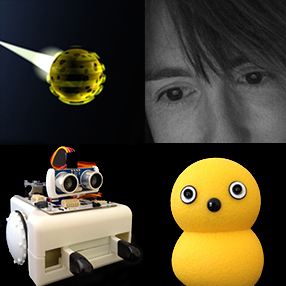I have just been to visit the wheelchair robots Fish and Bird, at their home, the Centre for Social Robotics (CSR) part of the Australian Centre for Field Robotics (ACFR).
These robots have been built to look like slightly smaller than standard wheelchairs. They are beautifully finished, the materials are in keeping with the idea of the wheelchair, but also seem lighter and more delicate. Their wiring and circuitry is cleverly hidden beneath the seat section. One of the most surprising, and I think important, things is that these robots are autonomous in a such a way that the complete installation is robust. They have simple switches: on, off and charging. They have been designed to be easy to look after (for the curator’s of exhibitions and their staff); there are no complex processes that need to be followed, for example to install certain programs as part of their set up. These robots have been designed to work over a long period of time, with minimal technical attention.
The only thing that exhibition staff need to be taught is how to catch them! You need to have a strategy to get hold of them and stop them “running away” when you need to recharge them or “rest” them overnight. I think this is just fantastic!
Of course, and unfortunately, these robots were out of action when I visited. However, it is still really good to have seen them up close. It was also very useful to be able to discuss their design, and the future plans of the CSR project team. In particular, I had the opportunity to talk to the artist Mari Velonaki and the roboticists Steve Scheding and David Rye at the same time. I got a clear idea of their technical goals, philosophical ideas and the way in which they all work together as a project team. All of this is relevant to my thesis work, and it was a good visit to have made just before my research trip to the US and Canada.

